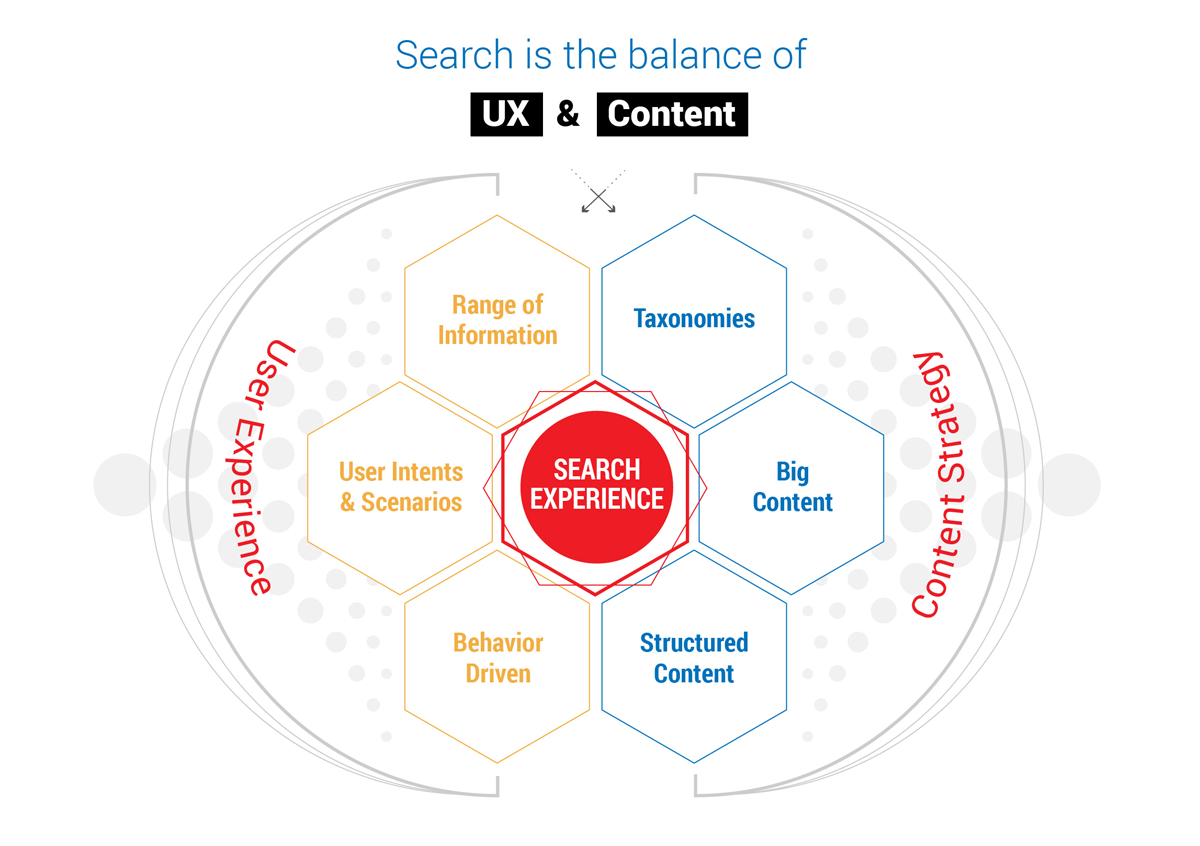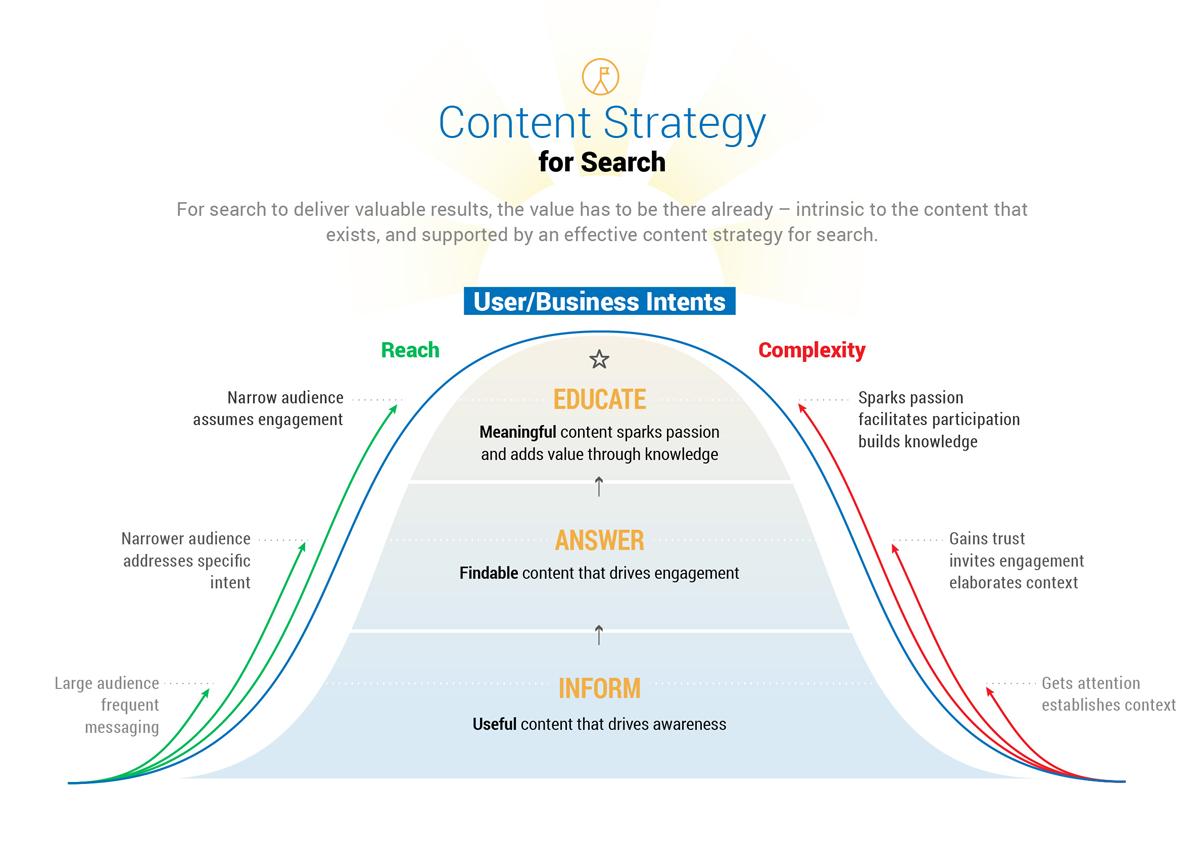Empowering Employees Through Search Design

Despite transformative advancements and investments in digital technologies, findability is still the top reported pain point for employees in the enterprise. Addressing findability is a critical problem to solve, especially as digital transformation evolves the employee experience into a delightful and engaging channel. When search is considered as a critical part of the employee experience, it delivers capabilities that enable and engage employees broadly.
"'Knowledge workers spend 5-15% of their time reading information, but up to 50% of their time' looking for it." Docurated
This is the age of Google. When people need new information, they assume that they can search for it, find it, and assimilate it themselves. Employees bring these expectations to work and rely on search to find information about topics and knowledge that matter most to them, when they need it. Enterprise capabilities are still in the process of catching up to the larger opportunity that search represents. It’s not that the answers aren’t out there – it’s just that people can’t find them.
Companies often face challenges in delivering a good basic search experience, which for employees means pain points around finding information, people, resources, services, and knowledge across the enterprise. But industry practices are evolving to meet these challenges and identifying new opportunities for search.1 The most successful companies are prioritizing search as a key driver of the employee experience. Broader integration and improved user interfaces are moving search closer to the consumer-grade experience employees expect, and there is an opportunity to enable intelligent, relevant search that serves as a primary pathway to knowledge and engagement.
"'44% of the time, employees can’t find the information they need to do their jobs" IDC
Search should harness capabilities like semantics and natural language processing, data-driven personalization, and predictive recommendations to provide more relevant results and contextualize them based on user intents, scenarios, and business priorities. These solutions can streamline findability, improve the efficiency with which information is delivered, and encourage broader exploration and dissemination of organizational knowledge.
Designing for these outcomes requires that content, UX and design challenges specific to the enterprise context are addressed. A people-centric approach that considers user experience, content strategy, and best practices holistically can imagine and realize a relevant and meaningful search experience for people.
Content challenges for enterprises
"'In the future state the best result for more than 50% of searches at leading global companies will not be a textual document" GartnerThe content challenges of search for enterprises are varied and far-reaching. Many large organizations house enormous amounts of information, which can balloon by 200% annually.2 Content and data live in siloed intranets, repositories, and databases. The scope of search often does not extend across the ecosystem, making the search experience itself fragmented. There is a mix of unstructured content (like documents and media) that is unindexed and untagged, and structured content housed in the content management system, data warehouses, and core systems.
For businesses and their employees, this is a tremendous opportunity. A high-performing search experience could help workers take back the hundreds of hours per year they might spend looking for content and, if they can’t find it, duplicating work that’s already been done. Beyond making content findable – a transformative capability in itself – search results can present desired information in meaningful contexts, which help people understand what they are reading and guide them to use that information effectively.3 Semantic search, hyper-personalization, omni-channel experiences, and other functionalities that are already pervasive in the consumer space hold the potential for businesses to manage their content as an enterprise asset, delivering knowledge proactively and enabling employees to put it to use.
We see a need to design for search as a critical part of the employee experience
As the value of an empowering search experience becomes more urgently clear, so too does the need for a coordinated design approach that considers the needs and expectations of people, the priorities of the organization, and the search capabilities that technology can enable. This means designing search to help people work the way they want, find the information they need, and keep pace with the proliferation of knowledge inside the enterprise.
To meet these aims, a search experience should deliver:
- A relevant, personalized, intelligent experience that pushes information, knowledge, and communications to people via all relevant channels and touchpoints
- A primary pathway to content that gives flexibility to find the information they need and control and manipulate results the way they want
- High-quality, meaningful content addressing business context and user intent and surfacing appropriate references and resources as necessary
And the experience should evolve over time, where short-term outcomes address good findability and relevancy and long-term design objectives support engagement, new business capabilities, and innovation.

UX design drivers
A people-centric design approach must always balance user needs and expectations with business priorities and goals. User experience considers the following for a cohesive consumer-grade search experience:
- Broader integration: Expanded access to content, resources, and data across the ecosystem as appropriate, providing a meaningful and useful experience aligned to business objectives
- User intents: A solid understanding of users and what they are trying accomplish through search with defined user intents and scenarios, leveraged as a design input for a more personalized and targeted search experience
- Behavior-driven results: Anticipated behaviors and patterns of use, informed by key traits of interactions, search terms, task and device paths and driving more relevant search experiences.
In addition to a consumer-grade experience, we foresee new opportunities as new digital technologies and capabilities evolve the employee experience. Gaining a deeper understanding of these capabilities, such as artificial intelligence, chat bots, and virtual assistant technology can help us design for a search experience that performs as a personal assistant. This paradigm could work across touchpoints and channels and be experienced through advanced and emerging interface modalities to deliver predictive and proactive search results.
Content strategy enablers
"Large organizations house enormous amounts of information, which can balloon by 200% annually" Docurated
When it comes to enterprise content – which is voluminous, highly variable, and difficult to govern – content strategy is indispensable. The quality of the search experience has direct and fundamental ties to the structure, governance, and classification of content. Content strategy as an enabler for search addresses three key elements:
- Big content: Making unstructured content, including documents and other media, classifiable and findable
- Structured content: Supporting rich contexts in search results through content snippets and other-search optimized content types, and enabling findability of personalized content across the ecosystem
- Taxonomies: Using controlled vocabularies and other classification practices to prioritize and organize search results, including structured and unstructured content
Together, these approaches support search experiences that provide relevance, context, and findability. Unstructured content is the backbone of enterprise knowledge, comprising documents, media, blogs, and any other long-form content that lives in the ecosystem. Structured content is the insight – the personal information, business intelligence, and system data that drives decision and action. And taxonomies, by helping search engines determine what the content is about (its “aboutness”), guide the classification of all this content to help search surface relationships that are meaningful to employees and drive good outcomes for the business.
There’s an obvious point here, one that bears repetition because it is so often missed. You just can’t deliver good search experiences if the value isn’t already present in your content. The best technological capabilities, the savviest strategy, and the slickest design won’t yield good user experience outcomes if the search results don’t include what employees were looking for. Every piece of content should address employee intents and expectations and be optimized so that search engines can find it.

The designation of “valuable content” is relative4. Depending on the employee intent, the scenario, or the priorities of the business, search should deliver different content that does different things in service of a defined context. For broad user intents and far-reaching business objectives, search should be broad in its reach and deliver low-complexity results, enabling employees to explore or drill deeper to find more information. When the intent or query is more focused, content should be narrow-casted to surface highly relevant content that is actionable, empowering, and specific to the employee.
A content strategy that runs wide and deep will include content inventory, maintenance, classification, and targeting that, in alignment with the user experience principles outlined above, deliver the right content, at the right time, to the right employees. With a solid strategy, the ability of search to deliver personalized, relevant, and contextualized results is both sustainable and scalable, allowing UX and content to evolve dynamically as technological capabilities can support them.
Start with strategy
Creating a great search experience for employees isn’t simple, but doing so can transform a business by delivering on the value of its knowledge. By starting with a holistic strategy that defines the role of search within the employee experience, it’s possible to improve findability in the near-term and plan for new capabilities over time.
At LDS, we apply our knowledge, experience, and methodology to design with a well-reasoned understanding of the business and people landscapes our solutions will impact. For search – a fundamental tenet of the digital experience that employees need and expect – such an informed approach is crucial. It is the foundation of a search experience that drives findability, innovation, and better work practices – fueling an employee experience that is differentiating.
1. Gartner Magic Quadrant for Enterprise Search – Gartner2. The Definitive Guide to Enterprise Search – Docurated
3. The Knowledge Quotient: Unlocking the Hidden Value of Information Using Search and Content Analytics — IDC
4. Busting the Field of Dreams Theory: Making Content Meaningful, Useful, and Findable – Misty Weaver
About this whitepaper
POSTED: September 12th, 2016
TAGS: content strategy, digital ecosystems, enterprise content management, human-centered design, learning workers, operational excellence, worker experience
